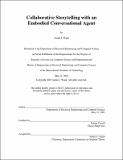| dc.contributor.advisor | Justine Cassell. | en_US |
| dc.contributor.author | Wang, Austin J. (Austin Jesse), 1980- | en_US |
| dc.contributor.other | Massachusetts Institute of Technology. Dept. of Electrical Engineering and Computer Science. | en_US |
| dc.date.accessioned | 2005-05-19T15:30:42Z | |
| dc.date.available | 2005-05-19T15:30:42Z | |
| dc.date.copyright | 2003 | en_US |
| dc.date.issued | 2003 | en_US |
| dc.identifier.uri | http://hdl.handle.net/1721.1/16976 | |
| dc.description | Thesis (M.Eng.)--Massachusetts Institute of Technology, Dept. of Electrical Engineering and Computer Science, 2003. | en_US |
| dc.description | Leaves not numbered. | en_US |
| dc.description | Includes bibliographical references (leaves [60]-[64]). | en_US |
| dc.description | This electronic version was submitted by the student author. The certified thesis is available in the Institute Archives and Special Collections. | en_US |
| dc.description.abstract | When children tell stories to their peers, they naturally collaborate with each other: coauthoring stories, corroborating when in doubt, and acting as active listeners. Their reliance on each other during, as well as the creative process itself, benefits their literacy development. If an interactive system were to engage a child in collaborative narrative, it would be able to exert greater influence over the child's language processes, without becoming overly intrusive as to obstruct his/her natural behaviors. However, due to the spontaneous nature of improvisational play, the problem becomes a challenging one from both a technical, and a behavioral standpoint. This thesis studies children's collaborative behaviors during storytelling and presents a model of the participants' roles, and how to initiate and participate in collaboration with appropriate speech acts and turn-taking cues. Furthermore, it demonstrates how technologies such as speech recognition, natural language processing with commonsense reasoning, multimodal interfaces, and floor management are critical to realizing a real-time collaborative interaction between children and an embodied conversational agent. | en_US |
| dc.description.statementofresponsibility | bu Austin J. Wang. | en_US |
| dc.format.extent | [68] leaves | en_US |
| dc.format.extent | 450821 bytes | |
| dc.format.extent | 450547 bytes | |
| dc.format.mimetype | application/pdf | |
| dc.format.mimetype | application/pdf | |
| dc.language.iso | eng | en_US |
| dc.publisher | Massachusetts Institute of Technology | en_US |
| dc.rights | M.I.T. theses are protected by copyright. They may be viewed from this source for any purpose, but reproduction or distribution in any format is prohibited without written permission. See provided URL for inquiries about permission. | en_US |
| dc.rights.uri | http://dspace.mit.edu/handle/1721.1/7582 | |
| dc.subject | Electrical Engineering and Computer Science. | en_US |
| dc.title | Collaborative storytelling with an embodied conversational agent | en_US |
| dc.type | Thesis | en_US |
| dc.description.degree | M.Eng. | en_US |
| dc.contributor.department | Massachusetts Institute of Technology. Department of Electrical Engineering and Computer Science | |
| dc.identifier.oclc | 53826650 | en_US |
